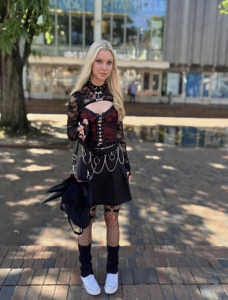
By Reagan Allen
When you think of a businessperson , the words “goth” or “emo” probably don’t cross your mind. However, Mary Eva Esposito says those terms aren’t mutually exclusive.
In 2021, like most teenagers, Esposito downloaded TikTok. Instead of posting videos doing dances, funny voice-overs or makeup tutorials, she started posting financial literacy lessons. Her aim? To help younger kids learn about financial independence.
Esposito wears black eyeliner, chained necklaces and eccentric fashion, all of which define her personal style. Black clothing and a beanie are her top picks when it comes to apparel. The contrast between her bleach-blond hair and black lipstick is striking.
She wants to break the stereotype for what an intelligent, successful woman should wear. Her bold style pushes boundaries and inspires others.
“The way I look should not validate or invalidate the merit of what I have to say,” Esposito said. “By dressing the way I do, I can resonate with people who also share the same style and sense of individuality, and so they will feel more comfortable learning from me than they would from say, a man.”
Whether she’s getting lunch with friends, in class, speaking at a business panel or making TikToks, her style doesn’t change. The UNC first-year is unapologetic when it comes to how she chooses to present herself.
Teaching with TikTok
Topics she discusses in her videos include the importance of building credit, how to start investing and futures trading. In her TikToks, Esposito sits up straight, makes eye contact with the camera and talks with her hands. She explains complex terms and ideas in a way the average person can understand.
The more popular videos on her @moneywithmary TikTok account have over 1 million views. One is titled “How to Afford a Car That Isn’t (poop emoji),” an issue most young people struggle with.
Not all her videos are tutorials. Esposito has gone around UNC’s campus, asking students questions like “How much money is in your bank account?” and “What is your biggest worry as a college student?” Afterwards, she offers financial advice to them and to others watching her videos.
Her TikToks aim to lessen the gap left by the education system. Esposito believes students should be taught more about finance and economics in school instead of topics most will never need to know in life, like calculus.
“The really big issue and a question I always ask is, ‘How are high school students expected to matriculate into the real world if they are not equipped with these necessary skills?’” she said.
Her TikToks helped her to win the 2022 BMTX Annual Financial Empowerment Scholarship. In her application, her videos, alongside various side hustles, played a huge role in helping her be chosen out of over 1,000 other applicants.
Esposito believes everyone should be taught about personal finance and how to manage money.
“Money is power,” she said. “So, when you neglect to teach people money, you are taking away their power.”
Odell Escorcia-Puente has been dating Esposito for the past year. They spend time together hiking, skateboarding and foraging for mushrooms. Both have edgy, alternative fashion styles.
Escorcia-Puente said Esposito introduced him to finance, teaching him things like how to make a brokerage account, wisely choose stocks and invest money. She didn’t just help Escorcia-Puente, she helped his family as well, creating a PowerPoint for them explaining the same concepts.
“I feel like using investing as a tool and being taught how to use that tool would be a good benefit for everybody,” Escorcia-Puente said.
From Hobby to Career
Her TikTok account is not only a passion, but a source of revenue. As a content creator, she gets paid by brands to promote products on her account, but she doesn’t stop there. Esposito sells crochet animals on her Instagram account, @shoppurplepear.
She learned to crochet in ninth grade after being hospitalized for an eating disorder. Having a hobby helped her during her recovery. Suddenly, an influx of people wanted to buy crochet plushies and Esposito needed to learn how to handle the money she was making.
“In disorder, I discovered my love for art. Art discovered my love for entrepreneurship and discovered my love for finance,” she said.
Four years later, Esposito committed to UNC and was accepted into the Kenan-Flagler Business School with a surplus of scholarships.
Both her parents and her older sister attended Harvard University. In her high-achieving family, Esposito always felt overlooked and in her sister’s shadow. Determined to make her own path, Esposito didn’t go down the Harvard route.
“Financial literacy is a way for me to differentiate myself. A creative, expressive outlet that’s unique to me,” she said.
She attributes her success to her upbringing, saying her attitude was cultivated in her when she was young.
“The saying in my household was that extra credit is never an option,” said Esposito.
She has received nothing but support from her family in her financial endeavors.
At UNC, she is an executive member of Smart Woman Securities at the Business School, which hosts seminars for women interested in learning about investing.
Amy Bugno is one of Esposito’s professors in the Business School. She says Esposito is a great example of what students can accomplish when they are intentional and dedicated to their career goals, and that it’s admirable to teach others about a topic where many are undereducated, including professionals.
“She makes it relatable and easy for her own generation to understand,” she said. .
Despite her passion for financial literacy, educational success, ambitious family and multiple revenue sources, Esposito believes being high-achieving isn’t all it’s cracked up to be. Relaxing and utilizing leisure time is something she struggles with constantly.
“I think that American hustle culture is a disease and I am sick. I have somehow convinced myself that productivity equals worth,” she said.
She says that having balance is essential for a healthy, happy life. She isn’t willing to give up on her passions or businesses, but plans to balance using her time to rest and complete goals.
For Esposito, a successful life is living in Asheville as an entrepreneur, financially independent and turning her home into a rescue sanctuary for senior Chihuahuas.
Edited by Will Christensen, Nathan Wellish and Claire Burch


